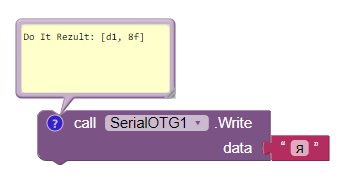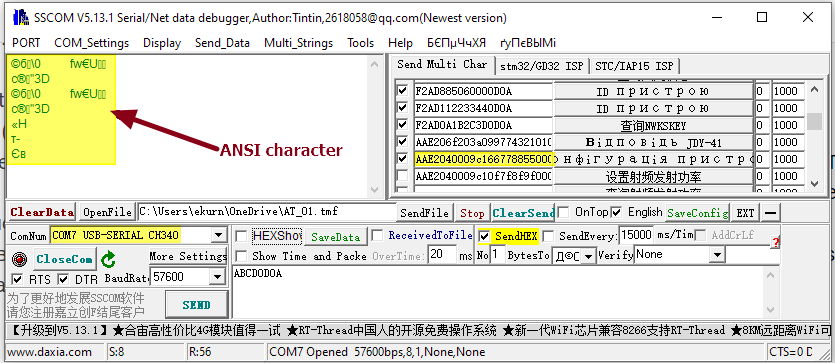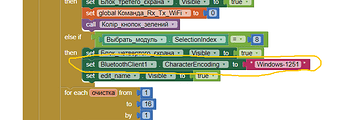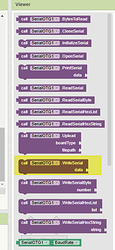Tell us what you want to receive by sending these characters and what you are getting now.
I need to manage a JDY-41 module.
JDY-41 transmits and receives ANSI table characters,
from "\0" to "я"
For example, the standard extension ai2 "BluetoothClient" ,
supports transmission of all ANSI characters (255 pcs.).
Standard component ai2. "Serial" (as well as "SerialOTG" views here),
only half of the ANSI character table (127 pieces) is transmitted.
I need the transmission to be characters (like "µ,¶, ,ё,№,є,",ј,S,ѕ,ї,А,Б,В....."),
the JDY-41 module then responds to the commands.
Here is a picture from my terminal
as you can see byte exchange
happens not .hex numbers, but characters from "\0" to "я"
Here I want to ask the experts
is it possible
expand the range of transmitted characters for "SerialOTG"?
Appinventor uses UTF8 encoding for strings/characters. It’s not compatible with ANSI.
ANSI encoding is normally associated with Microsoft and uses code pages to define characters with hex codes 0x80 – 0xff. Characters 0X00 – 0x7f are the same for ASCII, ANSI, UTF8 and can be used without problems in Appinventor to communicate with Arduino etc.
If you need access to characters 0x80 – 0xff you have to use bytes, that allows you to send/receive all 256 values. That was one reason for implementing SerialOTG.
Appinventor can work well with ANSI encoding as well.
Here is an example of how I set the encoding,
for the standard "BluetoothClient" component.
With such settings, the "BluetoothClient" component
successfully broadcast
hex code "0xff" as character "я".
OK, this is a property of the built in component for bluetooth communication.
SerialOTG already is a complex software that can handle many USB/serial adapters, communication as byte streams for bluetooth client/server, tcp/ip client/server, serial, as well as arduino programming. It’s to much work to expand it with ANSI characters with code page selection, signed/unsigned 1/2/4 byte numbers, byte order and more features that has been asked for.
So for now, you have to translate to/from bytes if you want to use SerialOTG.
Thanks for your work.
I already made an ANSI worksheet, for Java
static final String[] digitsHex1 = new String[]{"\u0000","\u0001","\u0002","\u0003","\u0004","\u0005","\u0006","\u0007","\b","\t","\n","\u000B","\f","\r","\u000E","\u000F","\u0010","\u0011"
,"\u0012","\u0013","\u0014","\u0015","\u0016","\u0017","\u0018","\u0019","\u001A","\u001B","\u001C","\u001D","\u001E","\u001F"," ","!","\"","#","$","%","&","'","(",")","*","+"
,",","-",".","/","0","1","2","3","4","5","6","7","8","9",":",";","<","=",">","?","@","A","B","C","D","E","F","G","H","I","J","K","L","M","N","O","P","Q","R","S","T","U","V","W"
,"X","Y","Z","[","\\","]","^","_","`","a","b","c","d","e","f", "g","h","i","j","k","l","m","n","o","p","q","r","s","t","u","v","w","x","y","z","{","|","}","~","\u007F"
,"Ђ","Ѓ","‚","ѓ","„","…","†","‡","€","‰","Љ","‹","Њ","Ќ","Ћ","Џ","ђ","‘","’","“","”","•","–","—","\u0098","™","љ","›","њ","ќ","ћ","џ"," ","Ў","ў","Ј","¤","Ґ","¦","§","Ё","©"
,"Є","«","¬","","®","Ї","°","±","І","і","ґ","µ","¶","·","ё","№","є","»","ј","Ѕ","ѕ","ї","А","Б","В","Г","Д","Е","Ж","З","И","Й","К","Л","М","Н","О","П","Р","С","Т","У"
,"Ф","Х","Ц","Ч","Ш","Щ","Ъ","Ы","Ь","Э","Ю","Я","а","б","в","г","д","е","ж","з","и","й","к","л","м","н","о","п","р","с","т","у","ф","х","ц","ч","ш","щ","ъ","ы","ь","э","ю","я"};
perhaps this will help somehow.
(I'm sorry in advance if i read your post wrong, because i am writing and reading a message through Google Translate)
Hope that will solve your problem. Good luck.
Have you tested the bluetooth component by setting the Windows-1251 encoding? Does it work for sure?
Yes, when I set the Windows-1251 encoding in the BluetoothClient.
The mobile app transmitted directly all the characters from "Ђ" to "я". (0x80 - 0xff).
Checked in the "iron" (Checked in hardware).
The receiving side was the arduino HC06 module.
So this extension could help?

Is hexadecimal data required or is decimal also accepted?
No, I have no problem converting ANSI characters to other number systems.
The problem is that it is not possible to broadcast these ANSI
symbols.
For example, when I, from a mobile application, transmit the character "я",
The receiving side receives , some two values "d18f".
And there's no way I can change it

SerialOtg has a WriteBytes block? Then convert the text to bytes and send the bytes.
WriteBytes? In this extension from the blocks that suits me,
I only see the WriteSerial block.
But it doesn't pass ANSI characters
First, use an extension to convert your text or character to ansi byte as shown above with my extension. And then send the obtained byte as a block WriteSerialByte or WriteSerialHexList. Don't send text over otgserial, only created bytes.
This is an old version of SerialOTG with suffix serial in the method names.
From the documentation:
Using single byte
ReadByte()
Read a byte as a number 0..255 from serial line, if empty return -1
WriteByte(num)
Write a number 0..255 as a byte to serial line
Using multiple bytes in lists
ReadBytes()
Read unsigned bytes 0..255 from serial line to a list.
WriteBytes(List)
Write unsigned bytes 0..255 in a list, to serial line.
Thank you, I need a little more time to figure it out.
From Monday I will continue to understand.
In the process of learning how the extension works,
there is something I don't understand
Single symbol "Ё" is not sent (blocks as in the picture)

Only the next time a character is sent (double-clicking on the button),

two characters "ЁЁ" are sent at once.
Maybe I don't understand How should I use the block set?
We do not know how you send and how you receive data. Show the blocks with which you have a problem and show the arduino code with which you receive data.
Now I use the program SerialOTG.aia
I downloaded it on the page GitHub - rkl099/Appinventor-SerialOTG: Appinventor extension SerialOTG with BT/WIFI client/server support, examples of apps and Arduino code, ver 1.5
If in this program we write a symbol,
as i showed in this picture

The symbol will not be sent with one click of the button.
If there are two clicks on the button,
the character will be sent to the terminal,
but only in the amount of 2 pieces.



